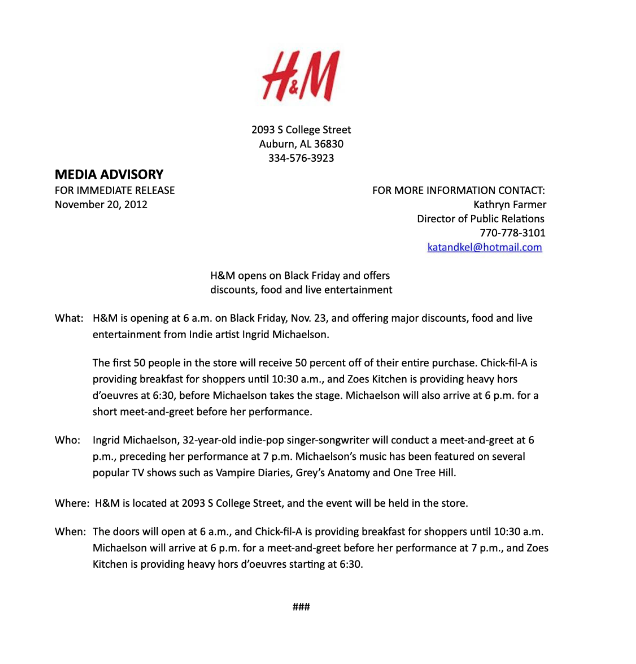In an increasingly digital world, the ways in which companies can communicate with their audience and attract attention are continually increasing. Most businesses will now use methods such as social media, online pay-per-click advertising, email campaigns, press releases and media alerts.
💡 Read Digital PR Explained: Best Strategies and Tools
But what is a media alert? Why are they useful? And when should you send one?
What is a Media Alert
A media alert (sometimes referred to as a media advisory) is a method of informing the media of an upcoming event. It acts as an invitation and contains key information only.
Companies use media alerts for events such as product launches, press conferences or charity events.

Media Alert vs Press Release
Press releases and media alerts are certainly similar, as they both set out to inform the media of an announcement. They both contain important information that the company wants to share. However, it is important to establish that they have distinct purposes. A media alert may be seen as a type of press release, but it serves a specific purpose as outlined above.
Let’s take a look at the differences between press releases and media alerts in more detail.
Read Track Press Release: Here’s How to Be Aware of All Online Publications
As the purpose of a media alert differs from a press release, there are some key differences in the way they are written and presented. A media alert is brief and concise, containing only basic information. A press release, however, is more detailed and reads more like an article.
While a press release aims to give a detailed overview of a particular event or initiative, a media alert serves more as an invitation. Their purpose is to attract members of the media to attend an event in the future. A press release, on the other hand, is usually sent retrospectively to inform the media about something important that has happened within the company.
The below table summarizes the key differences between the two:

How to Write a Media Alert
So you know that a media alert needs to be sent ahead of an event, it needs to be concise and contain only the necessary information. But how do you write one successfully? This will differ from writing an effective press release.
A good media alert entices members of the media to attend an event. They must include enough information to do this successfully, but should be no longer than a page in length. Ensure that it is in line with your overall branding too. Using a tool such as a branding proposal template from PandaDoc can help businesses define their branding or inform clients of a rebranding. Your media alert may even be inviting media to a rebranding launch!
To help you write an effective media alert, use the five Ws:
- Who?
- What?
- When?
- Where?
- Why?
Must-have information
More specifically, as media alerts are usually in reference to an event, the reader will need to know:
- Who are you? Include your company name and a brief description of your company if appropriate.
- What is the event? Make sure the recipient is clear of the event type. Is it a product launch? A grand opening?
- When is the event? Make it very clear when the event is taking place and ensure you give the recipients plenty of notice. Include the day, date and time of your event. You may include the duration of your event if appropriate.
- Where is the event? Include the full address including the zip code. Make it as easy as possible to attend.
- Why is the event being held? You will want to briefly explain the purpose of the event. Don’t give too much away here as you want to entice people to come to the event to find out more. However, they need to know enough information to spark their interest.
Read How to Write a Rebranding Press Release
Additional information
In addition, your media alert should contain:
- A brief but specific headline
- A sub-headline to add details about the event
- Contact information to allow reporters to get additional information if needed
- Event sponsor information
To help it stand out, consider bullet-pointing the information. This makes it very clear, concise and simple to read. You should also write “MEDIA ALERT” clearly at the top of your page so that the recipients are clear on the purpose.
Using integrated webhooks can be a really effective way to make your media alert user friendly and efficient. Webhook examples could be linking your event location, or including a link to your company website for journalists to find out more information about the company.
Social media and sales platforms are rapidly becoming key methods for businesses to communicate with their audience and attract attendees to their events. However, there is certainly still a place for using media alerts to communicate with journalists and other members of the media. The primary role of a media alert is to invite members of the media to an event, and it can be an effective way to generate publicity and media coverage for your business or event.
Use language that entices the reader to attend your event. This is particularly important when writing your headline and sub-headline. Make your media alert buzz-worthy rather than boring!
Finally, ensure your audience is clearly defined. Know who you are sending this media alert to and why. There’s more on this later.
What Does a Good Media Alert Look Like?
Now we know what a media alert is and what should be included, let’s look at an example of an effective media alert:
What makes it effective? Let’s unpick this below:
- Notice the brand logo is prominent. It is clear who has sent this media alert straight away.
- The address of the store is noted under the logo as well as later in the media alert. There is no confusion about where this event will be held.
- Contact details are available for recipients to find out more information if required.
- A brief headline gives an overview of the event.
- The media alert breaks down the five Ws in more detail and even uses the W words as indicators of information. This makes it easy for recipients to gather the information they require quickly and easily.
Recipients of this media alert are clear on who is hosting this event, why it is being held, what is involved, as well as when and where it will take place.
When should you send a media alert?
Social media is rapidly becoming a key method for businesses to communicate with their audience. Keeping up with social media trends is key for many businesses in the modern world. However, there is certainly still a place for using media alerts to communicate with journalists and other members of the media.
The primary role of such an alert is to invite members of the media to an event. It goes without saying then, that it should be sent ahead of an event with a specific date, time, location and purpose.
Media alerts are usually used for a specific, local audience. Ensure you send your media alert to the right people. For some events this may be journalists and photographers. For other events you may wish to attract bloggers or influencers in your field. If you are in the tech field and are launching a new product to convert PNG to PDF online, you will want to invite app developers or tech bloggers.
As you can see, the purpose of the event and the type of business you run will influence who you send your media alert to.
It is typical to see media alerts used for:
- Press conferences
- Book launches
- Grand openings
- Charity events
- Award ceremonies
- Art shows
- Live demonstrations
Typically, a media alert will be sent a few weeks before the event. Ensure you give your audience enough notice to attend. It is common to send another one again just a few days before the event to act as a reminder.
You may also want to follow up with a phone call or email to journalists to ensure they received the invite. Be careful with this, however, as you don’t want to be seen to be too pushy. You need to strike the balance of getting your message out there but not hounding the media about your event.
Final Comments
There is a specific scenario for which a media alert will be the most appropriate method of communication with the media. Use media alerts to inform a specific audience about an event, and create a buzz around it. You want to ensure your media alert uses the five Ws to include essential information without being cluttered or overly detailed.
An effective media alert can create a buzz around your upcoming event and ensure you have a media presence who will write positively about your event and your company.
Yauhen is the Director of Demand Generation at PandaDoc, an all-in-one document workflow platform to streamline, create, and use ready made templates including this PandaDoc Illinois bill of sale template. He’s been a marketer for 10+ years, and for the last five years, he’s been entirely focused on the electronic signature, proposal, and document management markets. Yauhen has experience speaking at niche conferences where he enjoys sharing his expertise with other curious marketers. And in his spare time, he is an avid fisherman and takes nearly 20 fishing trips every year.


